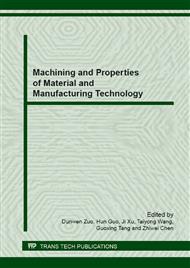[1]
D.E. Brehl, T.A. Dow. Review of vibration-assisted machining. Precision Engineering. 32(2008) 153-172.
DOI: 10.1016/j.precisioneng.2007.08.003
Google Scholar
[2]
K.I. Ishikawa, H. Suwabe, T. Nishide, et al. A study on combined vibration drilling by ultrasonic and low-frequency vibrations for hard and brittle materials. Precision Engineering. 22(1998)196-205.
DOI: 10.1016/s0141-6359(98)00014-2
Google Scholar
[3]
P.L. Guzzo, A.H. Shinohara. A Comparative Study on Ultrasonic Machining of Hard and Brittle Materials. Journal of Braz Soc of Mech Sci & Eng. 26(2004)56-61.
DOI: 10.1590/s1678-58782004000100010
Google Scholar
[4]
E. Brinksmeier, J.C. Aurich, E. Govekar, et al. Advances in modeling and simulation of grinding processes. CIRP Annals-Manufacturing Technology. 55(2006)667-696.
DOI: 10.1016/j.cirp.2006.10.003
Google Scholar
[5]
N. Qin, Z. Pei, C. Treadwell, et al. Physics-based predictive cutting force model in ultrasonic-vibration-assisted grinding for titanium drilling. Journal of Manufacturing Science and Engineering. 131(2009)41-52.
DOI: 10.1115/1.3159050
Google Scholar
[6]
D.F. Liu, W. Cong, Z. Pei, et al. A cutting force model for rotary ultrasonic machining of brittle materials. International Journal of Machine Tools and Manufacture. (2011).
DOI: 10.1016/j.ijmachtools.2011.09.006
Google Scholar
[7]
Z.J. Pei, P.M. Ferreira. An experimental investigation of rotary ultrasonic face milling. International Journal of Machine Tools and Manufacture. 39(1999)1327-1344.
DOI: 10.1016/s0890-6955(98)00093-5
Google Scholar
[8]
R.L. Hecker, I.M. Ramoneda, S.Y. Liang. Analysis of wheel topography and grit force for grinding process modeling. Journal of Manufacturing Processes. 5(2003)13-23.
DOI: 10.1016/s1526-6125(03)70036-x
Google Scholar
[9]
H.C. Chang, J.J.J. Wang. A stochastic grinding force model considering random grit distribution. International Journal of Machine Tools and Manufacture. 48(2008)1335-1344.
DOI: 10.1016/j.ijmachtools.2008.05.012
Google Scholar
[10]
D.B. Marshall, B.R. Lawn, A.G. Evans. Elastic/plastic indentation damage in ceramics: the lateral crack system. Journal of the American Ceramic Society. 65(1982)561-566.
DOI: 10.1111/j.1151-2916.1982.tb10782.x
Google Scholar


